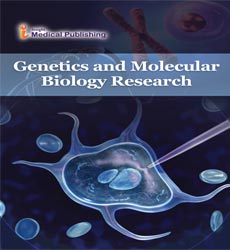A Brief Note on Mutations: A Literature Review
Priyanka Jain*
Department of Molecular & Cellular Physiology, International Institute of Information Technology, India
- Corresponding Author:
- Priyanka Jain
Department of Molecular & Cellular Physiology, International Institute of Information Technology, India
E-mail: priyankajain06@gmail.com
Received Date: May 08, 2021; Accepted Date: May 17, 2021; Published Date: June 10, 2021
Citation: Jain P (2021) A brief Note on Mutations: A literature Review. Genet Mol Biol Res Vol No: 5 Iss No: 3:46
Copyright: © 2021 Jain P. This is an open-access article distributed under the terms of the Creative Commons Attributions License, which permits unrestricted use, distribution and reproduction in any medium, provided the original author and source are credited.
Introduction
The genome consists of 1 to many long molecules of DNA, and mutation can occur potentially anywhere on these molecules at any time. the foremost serious changes happen within the functional units of DNA, the genes.
A mutated sort of a gene is named a mutant allele. A gene is usually composed of a regulatory region, which is liable for turning the gene’s transcription on and off at the acceptable times during development, and a coding region, which carries the ordering for the structure of a functional molecule, generally a protein. A protein may be a chain of usually several hundred amino acids.
Cells make 20 common amino acids, and it is the unique number and sequence of those that provides a protein its specific function. Each aminoalkanoic acid is encoded by a singular sequence, or codon, of three of the four possible base pairs within the DNA (A–T, T–A, G–C, and C–G, the individual letters pertaining to the four nitrogenous bases adenine, thymine, guanine, and cytosine).
Hence, a mutation that changes DNA sequence can change aminoalkanoic acid sequence and during this way potentially reduce or inactivate a protein’s function. A change within the DNA sequence of a gene’s regulatory region can adversely affect the timing and availability of the gene’s protein and cause serious cellular malfunction. On the opposite hand, many mutations are silent, showing no obvious effect at the functional level. Some silent mutations are within the DNA between genes, or they are of a kind that leads to no significant aminoalkanoic acid changes.
Mutations are of several types. Changes within genes are called point mutations. the only kinds are changes to single base pairs, called base-pair substitutions. Many of those substitute an incorrect aminoalkanoic acid within the corresponding position within the encoded protein, and of those an outsized proportion end in altered protein function.
Some base-pair substitutions produce a stop codon. Normally, when a stop codon occurs at the top of a gene, it stops protein synthesis, but, when it occurs in an abnormal position, it may result during a truncated and non-functional protein. Another sort of simple change, the deletion or insertion of single base pairs, generally features a profound effect on the protein because the protein’s synthesis, which is administered by the reading of triplet codons during a linear fashion from one end of the gene to the opposite, is thrown off. this alteration results in a frameshift in reading the gene such all amino acids are incorrect from the mutation onward. More-complex combinations of base substitutions, insertions, and deletions also can be observed in some mutant genes.
Mutations that span quite one gene are called chromosomal mutations because they affect the structure, function, and inheritance of whole DNA molecules (microscopically visible during a coiled state as chromosomes). Often these chromosome mutations result from one or more coincident breaks within the DNA molecules of the genome (possibly from exposure to energetic radiation), followed in some cases by faulty re-joining. during a diploid species (a species, like citizenry, that features a double set of chromosomes within the nucleus of every cell), deletions and duplications alter gene balance and sometimes end in abnormality. Inversions and translocations involve no loss or gain and are functionally normal unless an opportunity occurs within a gene.
However, at meiosis (the specialized nuclear divisions that happen during the assembly of gametes-i.e., eggs and sperm), faulty pairing of an inverted or translocated chromosome set with a traditional set may result in gametes and hence progeny with duplications and deletions.
Open Access Journals
- Aquaculture & Veterinary Science
- Chemistry & Chemical Sciences
- Clinical Sciences
- Engineering
- General Science
- Genetics & Molecular Biology
- Health Care & Nursing
- Immunology & Microbiology
- Materials Science
- Mathematics & Physics
- Medical Sciences
- Neurology & Psychiatry
- Oncology & Cancer Science
- Pharmaceutical Sciences
